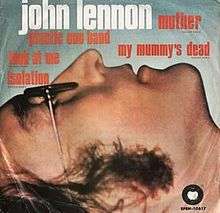My Mummy's Dead
| "My Mummy's Dead" | ||||
|---|---|---|---|---|
 1972 Mexican EP | ||||
| Song by John Lennon from the album John Lennon/Plastic Ono Band | ||||
| Released | 11 December 1970 | |||
| Recorded |
Summer 1970 House on Nimes Road in Bel Air, California | |||
| Genre | Folk | |||
| Length | 0:49 | |||
| Label | Apple Records | |||
| Writer(s) | John Lennon | |||
| Producer(s) | John Lennon, Yoko Ono, Phil Spector | |||
| John Lennon/Plastic Ono Band track listing | ||||
| ||||
"My Mummy's Dead" is the closing song on the album John Lennon/Plastic Ono Band by John Lennon. It was also released on a Mexican EP that also contained "Mother", "Isolation" and "Look at Me."
Writing
It is one of the songs Lennon wrote concerning his mother, along with "Julia" and "Mother".[1] The song is partially set to the tune of the English nursery rhyme "Three Blind Mice."[2][3] It is in the key of C sharp major.[4] It is performed on a solo acoustic guitar and played back through a small speaker.
Unlike the primal screams on "Mother," the opening song on Plastic Ono Band, "My Mummy's Dead" ends the album with John singing without emotion with a monotone delivery.[3] Author John Blaney suggests that Lennon's delivery "evokes a sense of Lennon's long-held emptiness."[3] Music critic Johnny Rogan finds that the song "captures the menace of childhood fears through adult remembrance in a most disturbing fashion."[2] Rock journalist Paul Du Noyer claims that the "blankness of John's delivery" makes the song one of the scariest and most chilling of Lennon's songs, despite being one of the simplest.[1] Lennon himself stated that the plain, short, childlike lyrics are due to him trying to write the song as a form of haiku.[1][2][3]
Recording
Two takes of "My Mummy's Dead" were recorded in Bel Air, California, during the summer of 1970 as part of the demo tapes Lennon made in preparation for Plastic Ono Band.[3][5] The first take was adapted for use on Plastic Ono Band.[5] Unlike the other Plastic Ono Band songs on the demos, "My Mummy's Dead" was not rerecorded for the album.[3][5] The second take was not processed and appeared on bootleg albums such as The Dream Is Over.[5] The second take version was edited with the version released on Plastic Ono Band to produce a more complete version of the song, which aired on The Lost Lennon Tapes.[5]
Reception
Authors Ben Urish and Ken Bielen describe "My Mummy's Dead" as "brief but powerful," stating that it produces a "memorable and chilling" effect and appropriately ends John Lennon/Plastic Ono Band by "capturing the essence of psychological pain and intimating at its persistence."[6] Blaney finds the song to be "a concise expression of Lennon's primal experience."[3] Music critic Wilfrid Mellers describes it as a "sickening cross between nursery rhyme...and TV commercial jingle" that takes us back to childhood in a "disabused and disillusioned" fashion.[4]
Mellers sees Lennon's later song "Oh Yoko!" from the Imagine to be a "positive counterpart" to "My Mummy's Dead," being addressed to his wife Yoko Ono rather than his mother.[4] Mellers notes that both songs are in the same key and utilise the "Three Blind Mice" melody, which is also reminiscent of the melody of the Beatles' "All You Need Is Love."[4]
Personnel
- John Lennon – vocals, acoustic guitar
Cover versions
The song was covered by The Minus 5 on The Lonesome Death of Buck McCoy.[7]
References
- 1 2 3 du Noyer, P. (1999). John Lennon: Whatever Gets You Through the Night. Thunder's Mouth Press. p. 34. ISBN 1560252103.
- 1 2 3 Rogan, J. (1997). The Complete Guide to the Music of John Lennon. Omnius Press. p. 47. ISBN 0711955999.
- 1 2 3 4 5 6 7 Blaney, J. (2007). Lennon and McCartney: together alone : a critical discography of their solo work. Jawbone Press. pp. 35, 39. ISBN 9781906002022.
- 1 2 3 4 Mellers, W. (1973). The Music of the Beatles. Schirmer Books. pp. 166, 176. ISBN 0-670-73598-1.
- 1 2 3 4 5 Madinger, C. & Easter, M. (2000). Eight Arms to Hold You. 44.1 Productions. p. 35. ISBN 0-615-11724-4.
- ↑ Urish, B. & Bielen, K. (2007). The Words and Music of John Lennon. Praeger. p. 24. ISBN 978-0-275-99180-7.
- ↑ Erlewine, S.T. "The Lonesome Death of Buck McCoy". Allmusic. Retrieved 21 December 2012.